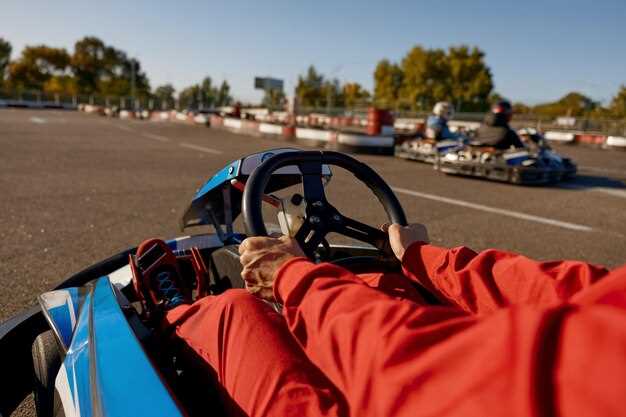
In the world of drag racing, the launch is the crucial moment that can either make or break your run. A perfect launch sets the tone for the rest of your race, enabling you to maximize your vehicle’s potential and secure a win. Understanding how to effectively launch your car is essential for anyone serious about their performance at the track. Here, we will explore key tips that will help you achieve the optimal start and gain a competitive edge.
Effective drag racing not only revolves around the power of your engine but also about mastering the art of the launch. Timing, throttle control, and tire grip all play significant roles in how successfully you can propel your vehicle off the starting line. In this article, we will examine various techniques and strategies to enhance your launch technique, ensuring that every enthusiast is well-equipped to achieve drag racing success.
By implementing the right practices into your routine, you’ll discover how to maximize acceleration right from the start. Whether you are a seasoned racer or a novice, honing your launch skills can significantly elevate your performance. Join us as we delve deeper into the mechanics of a proper launch that can propel you towards victory on the drag strip.
Understanding Launch Control Settings

Launch control is an essential feature for maximizing performance in drag racing. It helps drivers achieve the optimal start by managing engine speed and torque to minimize wheel spin. Here are some tips to understand and adjust your launch control settings effectively.
| Parameter | Description | Recommended Settings |
|---|---|---|
| Launch RPM | The engine speed at which the vehicle will launch. Too high may cause wheel spin; too low can result in sluggish starts. | 3000 – 6000 RPM, depending on tire grip and track conditions. |
| Throttle Position | Sets how much throttle is applied during the launch. Ensures gradual increase to prevent loss of traction. | 50% to 70% throttle, adjusting based on experience and track feedback. |
| Timing Control | Adjusts the ignition timing for the launch phase. Proper timing can improve acceleration and response. | Advanced by 2-5 degrees for better throttle response without knocking. |
| Boost Control | Regulates turbo or supercharger boost levels during launch. Helps maintain power without excessive wheel spin. | Start with a conservative boost setting; adjust based on testing. |
When using launch control, it’s important to practice repeatedly. Familiarize yourself with the characteristics of your car and how different settings affect performance. Small adjustments can lead to significant improvements in your racing success. Ultimately, mastering launch control settings is key to getting a strong start and building momentum on the track.
Optimal Tire Pressure for Maximum Grip
Achieving optimal tire pressure is crucial for maximizing grip during drag racing. Properly inflated tires help maintain traction, allowing for quicker acceleration and improved performance on the track. Here are some essential tips for determining the ideal tire pressure for your drag racing setup.
Understand Your Tire’s Specifications: Start by consulting the tire manufacturer’s recommendations. Each tire has a specified pressure range, and adhering to these guidelines is fundamental. Most drag racing tires perform best within a specific psi range, so knowing this information is key.
Adjust for Conditions: Tire pressure should be adjusted based on track conditions and ambient temperature. A warmer track may require slightly lower pressure to increase the contact patch, while colder conditions might benefit from a higher inflation level to maintain rigidity and responsiveness.
Determine Optimal Starting Pressure: A common starting point for drag racing tires is around 15-18 psi. However, experimentation is vital. Begin with this range and conduct practice launches, making small adjustments based on your vehicle’s response and track feedback.
Monitor and Adjust: Continuously monitor tire pressure before each run. Use a reliable pressure gauge and make adjustments after every run as needed. Keep in mind that tires heat up during racing, causing pressure to rise, which can affect grip. It’s wise to bleed off excess pressure if necessary to maintain optimal grip.
Test and Refine: The best way to find the optimal tire pressure is through consistent testing. Conduct runs at various pressures while analyzing your vehicle’s performance and grip levels. Make notes of the tire performance at different pressures to identify the sweet spot for your setup.
By paying attention to these factors and making informed adjustments to your tire pressure, you can enhance grip and improve your drag racing success. Proper tire management directly impacts acceleration, making it a vital element for any competitive racer.
Perfecting Your Reaction Time Techniques
In drag racing, reaction time can make or break your performance at the starting line. A minimal delay can lead to losing critical milliseconds in a race. Here are some tips to enhance your reaction time:
- Practice Consistently: Regular practice will help your body and mind synchronize better. Familiarize yourself with the starting lights and timing.
- Focus on the Lights: The tree’s lights play a vital role. The moment the last yellow light turns off, launch your car immediately. Count the lights in your head during practice to build muscle memory.
- Minimize Distractions: Ensure your focus is on the race. Eliminate any distractions in your environment that could impact your concentration.
- Use a Reaction Timer: Some devices can help you measure your reaction time. Analyze your performance and identify areas for improvement.
- Refine Your Launch Technique: Understand your vehicle’s capabilities. Practice your launch techniques to find the optimal balance between throttle response and traction.
Incorporating these tips into your drag racing preparation can significantly improve your reaction time. As you refine your techniques, you’ll find yourself gaining a competitive edge on the track.
Preparing Your Engine for a Successful Launch
Success in drag racing begins with a well-prepared engine. To maximize your car’s potential during launch, focus on these critical tips. First, ensure that your engine is in prime condition. Regular maintenance checks, including oil changes and appropriate fluid levels, are essential for optimal performance.
Next, consider the tuning of your engine management system. This adjustment optimizes fuel delivery and ignition timing, providing the necessary power and responsiveness at launch. A perfectly tuned engine will help prevent stalling or excessive wheel spin during takeoff.
Another important aspect is the temperature of your engine. Prior to racing, allow your car to reach normal operating temperature. A cold engine may not perform efficiently, while an overheated engine can lead to significant power loss. Monitor temperature levels before you line up for your run.
Additionally, focus on your throttle response. Ensuring quick and precise throttle action will allow for a more effective launch. Consider adjusting your throttle cable for optimal engagement, giving you an edge as soon as the race starts.
Lastly, practice your launch technique. Familiarize yourself with the power band of your engine, and find the optimal RPM for launching. This practice will enable you to make the most of your engine’s capabilities, leading to faster and more consistent starts during races.
Weight Distribution and Its Impact on Performance
The weight distribution of a vehicle plays a crucial role in its performance during a drag race. Proper weight distribution affects traction, acceleration, and overall launch efficiency. In drag racing, where every millisecond counts, understanding how weight influences your car’s dynamics can provide a significant advantage.
When launching from the starting line, a car with a balanced weight distribution is more likely to achieve optimal traction. If the weight is predominantly on the front tires, the rear tires can lose grip during acceleration, leading to wheel spin. Conversely, if too much weight rests on the rear, it may cause the car to become unstable, impairing its ability to maintain a straight line.
To achieve an effective launch, many racers focus on achieving a near-50/50 weight distribution. This setup allows both the front and rear tires to engage evenly, maximizing grip and translating power effectively to the ground. Different setups, such as adjusting suspension and using weight transfer techniques, can further enhance performance by optimizing the load on each tire during a launch.
Furthermore, modifying weight distribution can fine-tune a car’s behavior under acceleration. A lighter front end may enhance responsiveness and reduce the likelihood of wheel hop, while an appropriately balanced rear can promote stability. Understanding these principles will help racers make informed adjustments to their vehicles, ultimately leading to improved performance on the drag strip.
In conclusion, weight distribution is a pivotal factor in drag racing that directly impacts launch success. Mastering this aspect of vehicle setup can lead to substantial improvements in traction, acceleration, and overall race outcomes.
Common Mistakes to Avoid During Launch

When participating in drag racing, the launch phase is critical to achieving a successful run. Many racers make common mistakes that can hinder their performance on the track. Understanding these pitfalls can help improve your drag racing outcomes.
One prevalent mistake is failing to manage wheel spin effectively. Excessive wheel spin can cause a loss of traction, resulting in a slower time. To mitigate this, apply power gradually and avoid dropping the clutch abruptly. Proper throttle control during the launch phase is crucial for maintaining grip and maximizing acceleration.
Another mistake is not paying attention to tire pressure. Incorrect tire pressure can significantly affect traction and overall performance. Ensure that your tires are set to the optimal pressure for drag racing, allowing for better contact with the surface and improved stability during the launch.
Many racers also overlook the importance of staging their vehicle correctly. Inconsistent staging can lead to a poor reaction time, affecting the overall outcome of the race. Practice your staging technique to make sure you consistently hit the optimal position, which can enhance your launch timing.
A common oversight is neglecting the car’s weight distribution. An unbalanced vehicle can hinder acceleration, resulting in slower launch times. Adjusting weight and ensuring a balanced setup can lead to improved performance, especially off the line.
Finally, underestimating the impact of reaction time can be detrimental. Many racers focus solely on vehicle performance and forget to work on their reaction times. Practicing your start technique and understanding the importance of timing can make a significant difference in your drag racing success.






